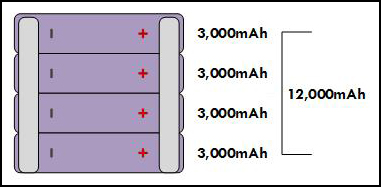Originally published at: https://esk8.news/esk8-iq-the-math-and-the-science-of-electric-skateboarding-part-1/
Before we get started with the meat of the article, I would like to present a spreadsheet of the formulas and processes that can be used to define the values associated with building and riding an electric skateboard. Here you will find methods for defining gear ratio, range, battery watt-hour usage, etc. If you have a question, don’t understand something or see that I missed something please leave a comment.

This isn’t an easy topic if you don’t have a background in math and/or engineering. That being said, most of these points/formulas are fairly simple individually. You will need to put them together and understand the interoperations to be able to define the values discussed here. It’s not as hard as it sounds, so hopefiully you should still be able to follow along.
Let’s Start With Batteries
First, let’s talk about batteries, or battery packs to be specific. I’m going to explain from a voltage and capacity point of view what it does for you in your board.
Battery pack voltages are not constant and are essentially theoretical as the values are defined by the number of cells in each parallel group, then each series group, then how much drain or charge they have had. Essentially they are elusive unicorns and you should just give up now.
You’re still here and you’ve got your grownup pants on, I’m proud of you. Now, lets get started, shall we?
Battery Pack Voltage Values
| Nominal | Peak | |
| 6S | 21.6v | 25.2v |
| 8S | 28.8v | 33.6v |
| 9S | 32.4v | 37.8v |
| 10S | 36.0v | 42.0v |
| 11s | 39.6v | 46.2v |
| 12s | 43.2v | 50.4v |
As an example for this lesson, let’s pretend you have a brand spanking new 10s4p pack (as it’s pretty common) and you are just dying to get it installed so you can ride! Damn dude, go for it, what’s the worst that can happen? Well, you could blow your silly ass up unless you understand what it is and how its specific values pertain to the rest of the electronics in your board.
So, back to the 10s4p battery pack. A 10S4P pack will have 10 cell groups in series, with each cell group having four cells in parallel. Before we get seeping into that though, let’s look at individual cells for a second.
Battery Type Voltage Values
| Type | Nominal | Full |
| Li-Ion | 3.6v per cell | 4.2v per cell |
| Lipo | 3.7v per cell | 4.2v per cell |
In our example we are looking at Li-Ion cells, specifically Samsung 30Q. You can click that little link if you want to know more, but the TL;DR version is it has 3000mAh of power and will dump up to 20 amps. The data sheet will tell you 15 amps, but it has been tested and this cell is underrated, trust me.
Each one of these cells is 3.6 volts nominal. So if you take 4 of those cells and put them in a parallel group, you end up with 12,000mAh of go juice at 3.6 volts, like so:

And if you stack 10 individual cells up in a series group as pictured below, you end up with 36 volts nominal.
So when you put it all together with four cells in each parallel group, and 10 parallel groups in series, you get a pack with 12,000mAh of power at 36 volts.
At one end you have a positive lead and at the other end you have a negative lead. Don’t get them mixed up, those bastards bite and it can get expensive to replace.
So, there it is. That’s how your battery works. There are just a couple more points I would like to make; if you’ve been here this long you can wait 2 more minutes, so sit back down. I SAID SIT DOWN!
You don’t want to over-discharge your battery. What this means is you don’t want to discharge your batter to below rated voltages, which is typically 2.8 volts per cell on the spec sheets. If you do this, it wont work anymore, to put it mildly. It will simply be too dangerous to attempt to charge, as the cell chemistry can become unstable and cause a fire or cause the cells to “vent”, which basically means letting gasses out as the bad reaction continues until completion. That’s why we set cutoff limits and why BMS’s have built in cutoff limits. People will argue until the second coming of Skatan about what those limits should be. A safe cutoff is 3.2v per cell, or 32v for a 10s battery pack. Setting the cutoff that high above the rated maximum discharge is a good way to extend the pack’s over-all life expectancy.
Charge limits are equally important. Don’t charge cells to more than 4.2v per cell or 42v for a 10s pack. In fact, it is often recommended to only charge cells to 4.1 volts or even 4.15 volts to help extend total pack life. If you do over charge it will at a minimum decrease the life expectancy of the pack. At worst it could set your dumb ass on fire…so don’t do it.
That’s it. I’ll cover more about batteries and formulas and how I tend to yell a lot and am generally querulous in the next part of ESK8 IQ: The Math and the Science of Electric Skateboards – Part 2.

